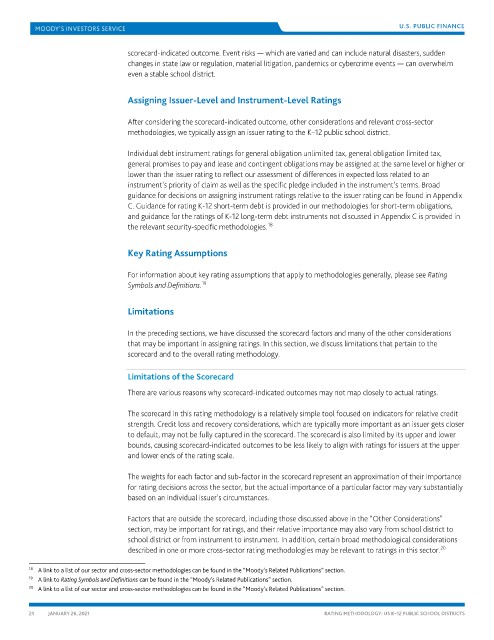Page 1655 - draft
P. 1655
U.S. PUBLIC FINANCE
scorecard-indicated outcome. Event risks — which are varied and can include natural disasters, sudden
changes in state law or regulation, material litigation, pandemics or cybercrime events — can overwhelm
even a stable school district.
Assigning Issuer-Level and Instrument-Level Ratings
After considering the scorecard-indicated outcome, other considerations and relevant cross-sector
methodologies, we typically assign an issuer rating to the K–12 public school district.
Individual debt instrument ratings for general obligation unlimited tax, general obligation limited tax,
general promises to pay and lease and contingent obligations may be assigned at the same level or higher or
lower than the issuer rating to reflect our assessment of differences in expected loss related to an
instrument’s priority of claim as well as the specific pledge included in the instrument’s terms. Broad
guidance for decisions on assigning instrument ratings relative to the issuer rating can be found in Appendix
C. Guidance for rating K-12 short-term debt is provided in our methodologies for short-term obligations,
and guidance for the ratings of K-12 long-term debt instruments not discussed in Appendix C is provided in
the relevant security-specific methodologies.
18
Key Rating Assumptions
For information about key rating assumptions that apply to methodologies generally, please see Rating
19
Symbols and Definitions.
Limitations
In the preceding sections, we have discussed the scorecard factors and many of the other considerations
that may be important in assigning ratings. In this section, we discuss limitations that pertain to the
scorecard and to the overall rating methodology.
Limitations of the Scorecard
There are various reasons why scorecard-indicated outcomes may not map closely to actual ratings.
The scorecard in this rating methodology is a relatively simple tool focused on indicators for relative credit
strength. Credit loss and recovery considerations, which are typically more important as an issuer gets closer
to default, may not be fully captured in the scorecard. The scorecard is also limited by its upper and lower
bounds, causing scorecard-indicated outcomes to be less likely to align with ratings for issuers at the upper
and lower ends of the rating scale.
The weights for each factor and sub-factor in the scorecard represent an approximation of their importance
for rating decisions across the sector, but the actual importance of a particular factor may vary substantially
based on an individual issuer’s circumstances.
Factors that are outside the scorecard, including those discussed above in the “Other Considerations”
section, may be important for ratings, and their relative importance may also vary from school district to
school district or from instrument to instrument. In addition, certain broad methodological considerations
20
described in one or more cross-sector rating methodologies may be relevant to ratings in this sector.
18 A link to a list of our sector and cross-sector methodologies can be found in the “Moody’s Related Publications” section.
19 A link to Rating Symbols and Definitions can be found in the “Moody’s Related Publications” section.
20 A link to a list of our sector and cross-sector methodologies can be found in the “Moody’s Related Publications” section.
21 JANUARY 26, 2021 RATING METHODOLOGY: US K–12 PUBLIC SCHOOL DISTRICTS

